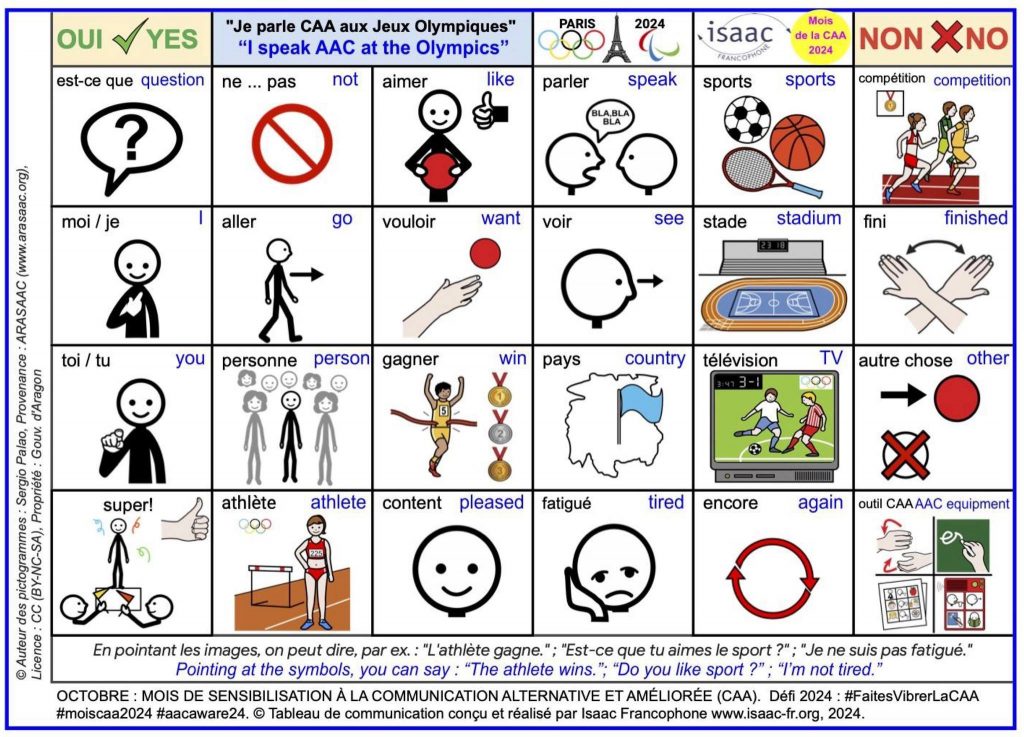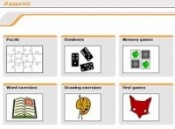AAC Resources
There are many good resources online pertaining to AAC. Below is a selection that reflects general information and best practices in the field of AAC. This list does not include vendor-specific websites, which also may contain good information related to their services and products.
ISAAC makes this information publicly available but does not warranty or make any representations regarding the content. We assume no liability or responsibility for any errors or omissions in the content or for any damages of any kind related to the use or misuse of this information.
- If you know of a good online resource that would be useful to people who use AAC, their families and supporters, please submit a request to post the link, to feedback(at)isaac-online.org.
Resource links
AAC at the Olympics! Speaking CAA at the Olympics!
On the occasion of the upcoming Olympic Games in Paris 2024 the ISAAC Francophone Association offers an example of a bilingual communication board: French/English

AAC-RERC
AAC-RERC is a Rehabilitation Engineering Research Center in the U.S. that functions as a collaborative research group dedicated to the development of effective AAC technology.
ACOLUG
Augmentative Communication Online Users’ Group is an international Internet communication forum established in 1995. Its primary purpose is to provide a way for people who use AAC to communicate with each other. Information is exchanged, friendships are forged, college students studying AAC learn from individuals who use AAC, wisdom and advice is shared, and research from the AAC-RERC is disseminated. ACOLUG has had a consistent membership of AAC users and parents of children who rely on AAC. Other members include manufacturers, researchers, practitioners, allies and university students.
To subscribe to ACOLUG, click here.
1. Send an email to listserv@temple.edu.
2. Leave the subject blank.
3. In the message type:
Subscribe acolug [your first name] [your last name]
Example: subscribe mary smith
4. Send message.
5. Use the reply function to the Command_Confirmation_ Request; leave the subject the same and in the body of the message, type the word “ok”.
6. You are now subscribed, so introduce yourself.
University of Nebraska – Lincoln College of Education and Human Sciences, AAC Click on the Resources tab for lists of AAC resources in sub-categories.
Hattie B. Munro Barkley Memorial Augmentative and Alternative Communication Centers This AAC website is designed to provide access to a wide range of information and resources related to the AAC effort. It is maintained by the Barkley AAC Center and the Munroe-Meyer Institute for Genetics and Rehabilitation at the University of Nebraska, USA.
Honoring and Including Students with Communication Differences
To ensure that all students have opportunities to communicate, teachers need to put structures and activities in place that allow for interaction. This article discusses honoring and including all learners in an inclusive classroom.
Augmentative Communication Inc. (ACI)
For over twenty years (1988-2009) Sarah Blackstone wrote and published the leading international newsletter in Augmentative Communication, Augmentative Communication News (ACN), distilling the ongoing research, exemplary practice, and new development activities in the field into a practical format that made it possible for clinicians, students and teachers to translate ongoing research and development into immediate practice. For fifteen years (1994-2009) Michael B. Williams, a gifted writer who relies on augmentative communication tools and strategies, wrote, edited, and oversaw the publications of Alternatively Speaking. This newsletter was written by and for people with complex communication needs and covered topics of personal and immediate interest to individuals who benefit using AAC.
Every issue of these two seminal publications in the field of AAC is now available (at no cost) to anyone who wishes to read and download them.
Communication Matters
You will find here information on methods of communication which can be used to supplement the more usual methods of speech and writing. Communication Matters is a UK-wide organization that helps people of all ages and ability who need to use AAC.
Communication Disabilities Access Canada (formerly ACCPC)
Based on a national survey, CDAC has developed guidelines and online resources to support businesses and organizations to improve accessibility for people who have speech and/or language disabilities. A series of eight e-learning modules address:
- communication with people who have communication disabilities
- supporting a person to understand what you are saying
- making meetings accessible
- communicating over the telephone
- providing accessible print and e-communications
- making accessible forms and supporting writing.
In addition, there are practical examples for how people with communication disabilities can apply the principles of human rights legislation when accessing goods and services in their community. The website is designed for businesses, organizations, accessibility legislators, people who have communication disabilities, family members and support services. Available in English and French.
Communication Access to Justice
Communication Disabilities Access Canada (formerly ACCPC) has a website portal containing webinars, best practice resources, procedures and guidelines about effective communication while giving and recording testimony or evidence. There is information about the role and responsibilities of a communication assistant within a legal / justice contexts and the techniques that can be used to support a victim / witness to communicate as accurately and completely as possible. This website is designed for police, lawyers, judges, victim witness services, people who have communication disabilities, family members and support services. Available in French and English.
AAC Intervention.com
This site offers many great tips and strategies from Dr. Caroline Musselwhite and Julie Maro in the US.
Pragmatics Profile of Everyday Communication Skills in Children
Free download of the Pragmatics Profile of Everyday Communication Skills in Children. This interview profile looks at the pragmatic functions of communication, regardless of form.
American Speech-Language-Hearing Association
Information and policy documents related to AAC, from the American Speech-Language-Hearing Association.
(http://papunet.net/english/)
Free and Inexpensive AAC Apps (www.centralcoastchildrensfoundation.org)
Glossary
A team of students working with ISAAC-Australia have compiled 150 AAC terms to create the new ISAAC Glossary of Terms and Definitions for AAC. The Glossary is available for free download from the ISAAC-Australia website.
You are invited to download and use the terms and definitions. The published source and a page number for each quote in the document is provided so that you can properly cite the original source.
Dr. Bronwyn Hemsley is continuing to collect translations of the 150 terms and definitions, and ISAAC members are invited to assist in updating and translating the Glossary. Details on how to help are included in the document.
